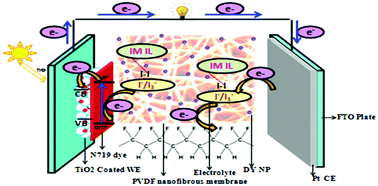Dye-sensitized solar cells based on an electrospun polymer nanocomposite membrane as electrolyte
Abstract
In this work an innovative quasi-solid state (QSS) polymer electrolyte containing rare earth oxide nanoparticles and an ionic liquid was developed to enhance the efficiency and stability of dye sensitized solar cells (DSSCs). For the fabrication of DSSCs, 3-decyl-1,2-dimethylimidazolium tetrafluoroborate ([dmim]BF4−) ionic liquid (IL) and dysprosium oxide nanoparticles (Dy NPs) were synthesized, characterized and introduced into electrospun polyvinylidene fluoride (PVDF) nanofibers. These nanofibers were studied by X-ray diffraction (XRD), Fourier transform infrared spectroscopy (FT-IR), diffuse reflectance spectroscopy (DRS-UV), differential scanning calorimetry (DSC), scanning electron microscopy (SEM), and transmission electron microscopy (TEM) techniques and examined for their electron uptake, porosity and ionic conductivity. The photovoltaic and electrochemical effects of this electrolyte in DSSCs were investigated. From the results, it was found that DSSCs assembled with IL and Dy NPs incorporated PVDF nanofibers had a higher conversion efficiency of 6.4% and they had better stability than liquid electrolyte. These polymer electrolyte based DSSCs were found to be stable and efficient and such electrolytes show promising potential for use in solar cells.



 Please wait while we load your content...
Please wait while we load your content...